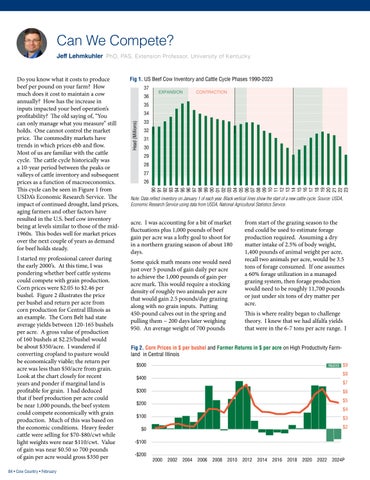Can We Compete? Jeff Lehmkuhler PhD, PAS, Extension Professor, University of Kentucky
40 ______________________________________________________________________________ 39 ______________________________________________________________________________
I started my professional career during the early 2000’s. At this time, I was pondering whether beef cattle systems could compete with grain production. Corn prices were $2.05 to $2.46 per bushel. Figure 2 illustrates the price per bushel and return per acre from corn production for Central Illinois as an example. The Corn Belt had state average yields between 120-165 bushels per acre. A gross value of production of 160 bushels at $2.25/bushel would be about $350/acre. I wandered if converting cropland to pasture would be economically viable; the return per acre was less than $50/acre from grain. Look at the chart closely for recent years and ponder if marginal land is profitable for grain. I had deduced that if beef production per acre could be near 1,000 pounds, the beef system could compete economically with grain production. Much of this was based on the economic conditions. Heavy feeder cattle were selling for $70-$80/cwt while light weights were near $110/cwt. Value of gain was near $0.50 so 700 pounds of gain per acre would gross $350 per 84 • Cow Country • February
______________________________________________________________________________ Fig 1. 38 US Beef Cow Inventory and Cattle Cycle Phases 1990-2023 37 ______________________________________________________________________________ EXPANSION CONTRACTION 36 ______________________________________________________________________________ 35 ______________________________________________________________________________ 34 ______________________________________________________________________________ Head (Millions)
33 ______________________________________________________________________________ 32 ______________________________________________________________________________ 31 ______________________________________________________________________________ 30 ______________________________________________________________________________ 29 ______________________________________________________________________________ 28 ______________________________________________________________________________ 27 ______________________________________________________________________________ 26 ______________________________________________________________________________ 90 91 92 93 94 95 96 97 98 99 00 01 02 03 04 05 06 07 08 09 10 11 12 13 14 15 16 17 18 19 20 21 22 23
Do you know what it costs to produce beef per pound on your farm? How much does it cost to maintain a cow annually? How has the increase in inputs impacted your beef operation’s profitability? The old saying of, “You can only manage what you measure” still holds. One cannot control the market price. The commodity markets have trends in which prices ebb and flow. Most of us are familiar with the cattle cycle. The cattle cycle historically was a 10-year period between the peaks or valleys of cattle inventory and subsequent prices as a function of macroeconomics. This cycle can be seen in Figure 1 from USDA’s Economic Research Service. The impact of continued drought, land prices, aging farmers and other factors have resulted in the U.S. beef cow inventory being at levels similar to those of the mid1960s. This bodes well for market prices over the next couple of years as demand for beef holds steady.
Note: Data reflect inventory on January 1 of each year. Black vertical lines show the start of a new cattle cycle. Source: USDA, Economic Research Service using data from USDA, National Agricultural Statistics Service.
acre. I was accounting for a bit of market fluctuations plus 1,000 pounds of beef gain per acre was a lofty goal to shoot for in a northern grazing season of about 180 days. Some quick math means one would need just over 5 pounds of gain daily per acre to achieve the 1,000 pounds of gain per acre mark. This would require a stocking density of roughly two animals per acre that would gain 2.5 pounds/day grazing along with no grain inputs. Putting 450-pound calves out in the spring and pulling them ~ 200 days later weighing 950. An average weight of 700 pounds
from start of the grazing season to the end could be used to estimate forage production required. Assuming a dry matter intake of 2.5% of body weight, 1,400 pounds of animal weight per acre, recall two animals per acre, would be 3.5 tons of forage consumed. If one assumes a 60% forage utilization in a managed grazing system, then forage production would need to be roughly 11,700 pounds or just under six tons of dry matter per acre. This is where reality began to challenge theory. I knew that we had alfalfa yields that were in the 6-7 tons per acre range. I
Fig 2. Corn Prices in $ per bushel and Farmer Returns in $ per acre on High Productivity Farmland in Central Illinois $500
_____________________________________________________________________________ PROJECTED $9
$300
_____________________________________________________________________________ $8 $7 _____________________________________________________________________________ $6
$200
_____________________________________________________________________________ $5
$100
_____________________________________________________________________________
$400
$0
$4 $3
_____________________________________________________________________________ $2
-$100
_____________________________________________________________________________
-$200
_____________________________________________________________________________ 2000 2002 2004 2006 2008 2010 2012 2014 2016 2018 2020 2022 2024P
